I don’t think I need to say much about The Twilight Zone that hasn’t been already said. The original series was that rare combination of actual geniuses (mainstays Rod Serling, Charles Beaumont, Richard Matheson, George Clayton Johnson; and others like Ray Bradbury and Reginald Rose, author of 12 Angry Men) who were actively getting over on the CBS network.
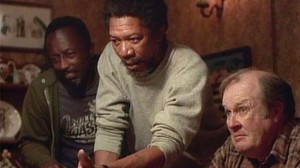 I say getting over because Serling had run into roadblocks with his controversial, thought-provoking television plays. He could put up a Patterns or a Requiem For A Heavyweight — no slouches for drama — but when he wanted to hit upon the cultural divides in society like class distinctions, racism, the haves and have nots, he was given a firm and stinging “no” by his network handlers. The Twilight Zone was born from that stoppage. If Serling couldn’t present it as straight-ahead dramas, he’d fashion analogies and set it in science fiction and horror settings. He’d feed you a message in a way so you would never recognize you were being fed. And with his partners in this groundbreaking enterprise, he’d also amaze and scare the hell out of you.
I say getting over because Serling had run into roadblocks with his controversial, thought-provoking television plays. He could put up a Patterns or a Requiem For A Heavyweight — no slouches for drama — but when he wanted to hit upon the cultural divides in society like class distinctions, racism, the haves and have nots, he was given a firm and stinging “no” by his network handlers. The Twilight Zone was born from that stoppage. If Serling couldn’t present it as straight-ahead dramas, he’d fashion analogies and set it in science fiction and horror settings. He’d feed you a message in a way so you would never recognize you were being fed. And with his partners in this groundbreaking enterprise, he’d also amaze and scare the hell out of you.
But we’re not going to talk about that Twilight Zone. Instead, let’s look at the series from 1985. It’s not as groundbreaking and not as controversy-courting by any stretch. It was a solid bit of television that on a good day still had the nerve to make you think. The show came up from the most unlikely places: CBS’ standard-template dramedy/action show Simon & Simon and rival network NBC.
We’ll tackle the second one first. Although it has not, to my knowledge, ever been expressed outright, the Twilight Zone 2.0 seems to be a direct reaction to a show NBC was heavily promoting, with Executive Producer Steven Spielberg at the helm, his Amblin Entertainment company backing, and many of his Hollywood friends and peers making their way to the small screen to write, direct, and star. That show, Amazing Stories, looked for all the U.S. television world to see, like a monolith. It would be an anthology: less a series with recurring storylines. Instead it would allow Spielberg, Robert Zemeckis, Joe Dante, Chris Columbus, and a host of others to make mini-movies, self-contained half hour to one hour films. It would be in stereo, a new development for broadcast television. It promised the kind of eyeballs Spielberg commanded at the box office, and other networks were seemingly at a disadvantage.
Except, not really. CBS had bought the rights to the Twilight Zone properties from Serling and his stakeholders many years before (the Cayuga production company). They had their own supernatural-based anthology series mothballed, but ready to be removed, shaken out, and redressed for a new generation, and they had the golden ticket of name recognition. Yet there was a fundamental failure in their thinking that ultimately doomed the show to a very short and somewhat tumultuous life. For all the fame that The Twilight Zone had accrued, much of that was after the initial run of the series. It never did as poorly as Star Trek did in first-run — it survived five years to ST’s three — but it wasn’t an earth shaking titan of the broadcast medium either. It was a solid show that trudged along and made some very, very committed fans.
 It wasn’t until syndicated television came along, and the benefits of an anthology were fully realized, that Serling’s full presence could be recognized as brilliance. Syndication allowed for drop-in access because each episode was self-contained. If the baseball game was rained out, the TV station could drop in an episode. Network TV, even at that stage, was becoming appointment television. You dropped by at a certain time to see Marshall Dillon, or The Beav, or any other of your newfound television friendships. Without syndication, the Twilight Zone might have well remained a very good, but vaguely remembered show, because those personality attachments could never be made. Consequently, decades later when appointment TV wasn’t just the prominent aspect of television but the very medium itself, both Twilight Zone 2.0 and Amazing Stories would end up failing to pull necessary audiences…but we’re getting ahead of ourselves.
It wasn’t until syndicated television came along, and the benefits of an anthology were fully realized, that Serling’s full presence could be recognized as brilliance. Syndication allowed for drop-in access because each episode was self-contained. If the baseball game was rained out, the TV station could drop in an episode. Network TV, even at that stage, was becoming appointment television. You dropped by at a certain time to see Marshall Dillon, or The Beav, or any other of your newfound television friendships. Without syndication, the Twilight Zone might have well remained a very good, but vaguely remembered show, because those personality attachments could never be made. Consequently, decades later when appointment TV wasn’t just the prominent aspect of television but the very medium itself, both Twilight Zone 2.0 and Amazing Stories would end up failing to pull necessary audiences…but we’re getting ahead of ourselves.
CBS had the property with the brand name, they had the head-to-head competitor to challenge the Spielberg Steamroller, but they needed a guy that could keep the show ticking along on-time and on budget, which are two things genre productions regularly abuse. Philip DeGuere Jr. was a writer and producer best known as the creator and original executive producer of the television series Simon & Simon. That show starring Jameson Parker and Gerald McRaney ran on CBS from 1981 to 1988, and proved that DeGuere could keep things tamped down enough to satisfy the sausage casing the network was hoping to pump the ground product into. They were in a sense wrong. Yes, DeGuere’s managerial skills could be counted on to not bankrupt CBS, but here was a guy who genuinely loved the original show, and sought out collaborators who equally appreciated Serling’s vision, to present high quality mini-dramas that dazzled and scared, but also engaged the thought process. DeGuere was by no means a loose cannon, but he was neither a company man.
Staff writers Michael Cassutt (later of another series ahead of its time, Max Headroom) and George R.R. Martin, creator of the Game of Thrones saga, were working with names like Ray Bradbury, Arthur C. Clarke, and Stephen King. The show had big stars and up-and-comers too, on both sides of the camera. They even had the Grateful Dead’s Jerry Garcia, along with Merl Saunders, whip up a spooky new take on the theme song. In what was seen as a coup they also secured writer Harlan Ellison as a creative consultant (I told you, DeGuere was thinking big) and thus one of the series’ low points was about to begin. For the first season of the show Ellison submitted an adaptation of Donald E. Westlake’s story “Nackles.” It was for the Christmas edition of the show wherein a nasty man, drunk and sociopathic, scares kids with stories of an evil Santa Claus counterpart (perhaps a Gruss Von Krampus?)
Standards and Practices wasn’t having it, viewing this as a buzzkill that would taint the holly jolly mood CBS tried very bravely to maintain from the 1970s and 1980s. In a pre-ABC Family age, CBS has annual rights to A Charlie Brown Christmas, Rudolph The Red-Nosed Reindeer, Frosty The Snowman and a scad of other holiday delights. They weren’t going to muck it up with a Twilight Zone episode with a horrid misanthrope scaring kids on their most favorite time of the year, even if Harlan Ellison was slated to make his directorial debut with it. The interference, the lack of vision, and the general mistrust and misread of the audience was more than Ellison could take. He lashed out at CBS execs. They severed his services.
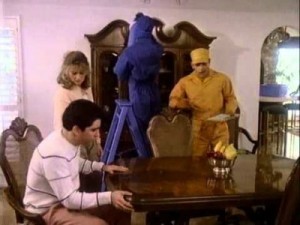 It wasn’t that terrible a blow, however. The truth is that TZ2 was limping along already. In a darkly comic quote, Executive Story Consultant Alan Brennert once said, “You have not known humiliation until you have been beaten by Webster and Mr. Belvedere.” Ellison would wind up back with the show in the flagging third season. What changed his (and CBS’) mind is difficult to say. Maybe they were desperate for that edge they were so scared of unsheathing in year one.
It wasn’t that terrible a blow, however. The truth is that TZ2 was limping along already. In a darkly comic quote, Executive Story Consultant Alan Brennert once said, “You have not known humiliation until you have been beaten by Webster and Mr. Belvedere.” Ellison would wind up back with the show in the flagging third season. What changed his (and CBS’) mind is difficult to say. Maybe they were desperate for that edge they were so scared of unsheathing in year one.
Cassutt would admit that the focus of TZ2 was a bit scattershot, that instead of honing in on what Twilight Zone meant and did best, they integrated several different elements that watered down the punch. He specifically noted that a sense of the show The Outer Limits had crept in too. The Outer Limits was often content to have a show just about people being chased by zombies or aliens, whereas The Twilight Zone would have always given deeper meaning to what and why the zombies and aliens were. One was all effect. The other was cause and effect.
Phillip DeGuere would later be coaxed to oversee a show on ABC based on a property from the U.K., about a digital television show host in a dystopian media-saturated world. He would take Cassutt with him. It is presumed that another figure, George Martin, was also prompted but his aesthetic didn’t fit into what the creators of this show, Max Headroom, were shooting for. It didn’t matter. Headroom failed after only a few years too. Genre shows were cannon-fodder across the board for the entire decade until Star Trek The Next Generation, born and bred in first-run syndication far away from network hesitance and fears, debuted. It was almost certain that shows like Amazing Stories, Max Headroom and Twilight Zone version two would fail.
I am, therefore, an untrustworthy narrator. These shows all appeared when I was in my middle school/high school days. I was into sci-fi, having been an insufferable Star Wars geek in the ’70s, and I enjoyed the idea that these shows were primed to mess with my mind (except, maybe, Amazing Stories which leaned heavily on Spielberg’s sense of sentimentality). My saying that these are neglected classics, disrespected and abused by decades of critique carry as much weight as when I extol the virtues of a specific song or band of the ’80s and you, the reader, turn up your nose and question my opinion on everything afterward. These are classics to me, but perhaps only to me.
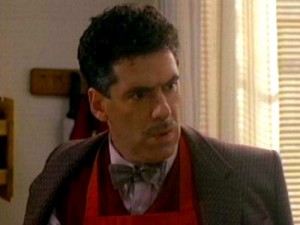 But the Twilight Zone reboot has its moments. In it we see for the very first time Bruce Willis in a deadly serious role, exhibiting layers nobody would have expected from his glib smart ass David Addison from Moonlighting. “Shatterday,” based on an Ellison short story and directed by Wes Craven, recounts the day a selfish, arrogant man makes a phone call home to find he is already there. His better nature, sick and tired of the life he has had to suffer with for being so failed a human being, has split off and assumed his life. Over the next few days the former life will begin a process of decay. He’ll reach out to his reformed character and exhibit the stages of grieving.
But the Twilight Zone reboot has its moments. In it we see for the very first time Bruce Willis in a deadly serious role, exhibiting layers nobody would have expected from his glib smart ass David Addison from Moonlighting. “Shatterday,” based on an Ellison short story and directed by Wes Craven, recounts the day a selfish, arrogant man makes a phone call home to find he is already there. His better nature, sick and tired of the life he has had to suffer with for being so failed a human being, has split off and assumed his life. Over the next few days the former life will begin a process of decay. He’ll reach out to his reformed character and exhibit the stages of grieving.
In “Nightcrawlers” a vietnam vet experiences flashbacks and, concurrently, is gaining the power of mind over matter. As directed by The Exorcist‘s William Friedkin, the former soldier cannot harness his mind and just as he can bend spoons with his brain, he is also prone to pulling his wartime demons into the present day. Seen through modern eyes, the story is a powerful fable to explain the harrowing effects of Post Traumatic Stress Disorder, and the horrors our soldiers must be saddled with for and long after their service.
Rock and Roll High School director Allan Arkush handles “The Misfortune Cookie” where a mean-spirited food critic, played by Elliot Gould, comes across a Chinese restaurant with truly prescient fortune cookie fortunes — all bad. When he confronts the owner, later in the story, and threatens him because the fortunes are clearly cursed and bring the critic bad luck, the owner says otherwise. The fortunes are not written so much as they are brought into existence based on the spirit of the person receiving the cookie. Good person, good fortune. Bad person, bad fortune. In the end, the critic finds he has died and been damned to a hell full of subpar Chinese restaurants, yet his hunger will not be satisfied. He’ll have to eat food he dislikes for all eternity and never be full enough to kill the pangs.
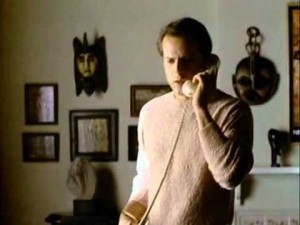 In a story that cleverly cribs from the original Twilight Zone playbook, and long before they used the same script-flip on The Simpsons, “A Small Talent For War” finds an alien culture interrupting a bickering U.N. meeting. Their envoy seemingly criticizes the Earth powers for their “small talent for war” and says they had better stop messing around, or else the alien invasion will begin in a matter of days. The world leaders fight among themselves, scramble and claw, but eventually hammer out a worldwide peace treaty. The alien envoy returns to find these superpowers resplendent in their accomplishment. “We did it,” they congratulate themselves. “We’ve averted your invasion.”
In a story that cleverly cribs from the original Twilight Zone playbook, and long before they used the same script-flip on The Simpsons, “A Small Talent For War” finds an alien culture interrupting a bickering U.N. meeting. Their envoy seemingly criticizes the Earth powers for their “small talent for war” and says they had better stop messing around, or else the alien invasion will begin in a matter of days. The world leaders fight among themselves, scramble and claw, but eventually hammer out a worldwide peace treaty. The alien envoy returns to find these superpowers resplendent in their accomplishment. “We did it,” they congratulate themselves. “We’ve averted your invasion.”
The envoy informs them that, to the contrary, theirs is a warlike race, a species of conquerors and pillagers. It wasn’t the war he was criticizing, but their small talent for it. A big talent for war might have raised them up as equals. Instead, the invasion will begin…immediately, and so it does.
There are home video editions of the TZ2 years, but people have complained that the quality of the presentations are lacking. The official explanation for it is that the show was shot on high quality film. However, every aspect thereafter, from editing to special effects and on, were accomplished in video and very early-stage computer generated imagery. In order to do a true remaster, the entire post-production effort would have to be done again after a thorough rescan of the film elements. These are efforts reserved for shows with a greater success rate than the ’80s Twilight Zone had.
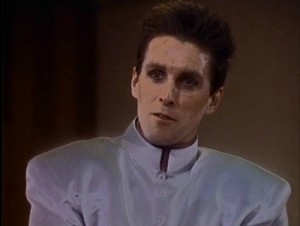 It’s unfortunate, now in what is being considered a new golden age of television, that the means to adequately judge materials from neglected years are still slim or in disrepair. While I don’t believe this show would rise to the lofty heights of it’s forefather, it might be seen in a more charitable light now.
It’s unfortunate, now in what is being considered a new golden age of television, that the means to adequately judge materials from neglected years are still slim or in disrepair. While I don’t believe this show would rise to the lofty heights of it’s forefather, it might be seen in a more charitable light now.
For myself, I miss the experimentalism, the risk taking, and the freshness of the anthology series form. It may be time for a comeback, especially in the more fragmented viewership that streaming, DVR, and Netflix binge-viewing offer.





Comments